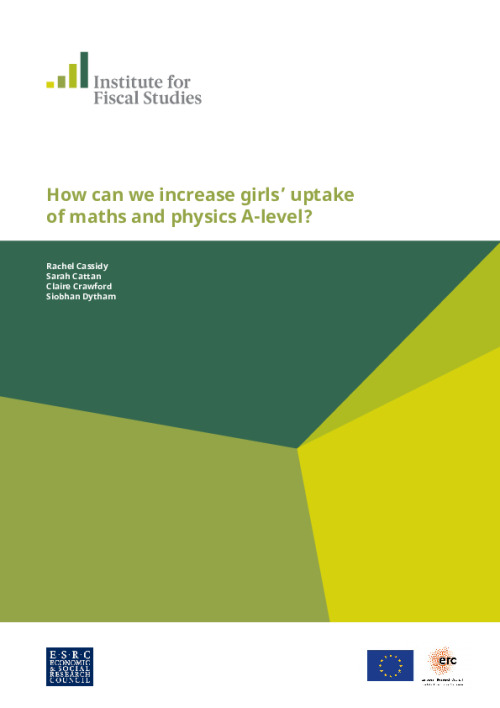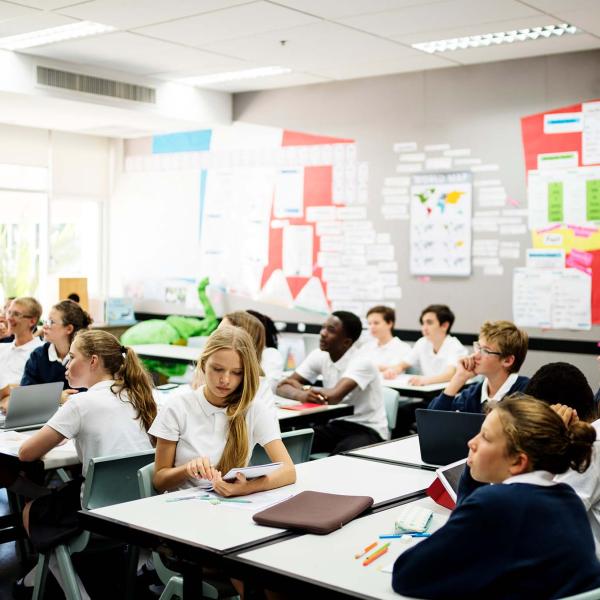There is a large gender gap in the likelihood of taking maths and physics at A-level, even among high-achieving pupils. Among pupils who achieved grade A or A* (equivalent to grades 7-9) in GCSE maths in 2010, 36.5% of girls compared to 51.1% of boys took maths A-level. Among those who achieved grade A or A* in GCSE physics, just 13.2% of girls compared to 39.3% of boys took physics A-level. By contrast, there is almost no gender gap in the likelihood of taking chemistry A-level amongst those who score highly in the subject at GCSE, and girls are actually more likely to take biology A-level than boys.
In partnership with the STEM Skills Fund, we conducted a study to understand thebarriers that stop girls from taking maths and physics at A-level. This took the form of a small-scale randomised control trial in which girls in Year 11 who were predicted to achieve at least grade 7 (equivalent to at least grade A) in maths, physics or combined science GCSE were offered financial support in return for applying to study physics or maths A-level. As part of this trial, we surveyed 266 girls, as well as a senior staff member across 40 schools, about girls’ A-level subject choices and what drives them. We also conducted four focus groups with 6-8 girls in schools in Bolton, Hull, Birmingham and Portsmouth to discuss these reasons in more detail.
Key Findings
A majority of girls report enjoying maths and physics, but some find the content and assessment methods off-putting, and are less happy with the quality of physics than maths teaching
77% of girls say they find maths interesting, and 83% report enjoying it, compared to 61% saying that they find physics interesting and 57% saying that they enjoy physics. Three quarters of girls report that the quality of maths teaching they have experienced so far is very good or outstanding, compared to just 38% who say the quality of physics teaching is similarly high. The focus groups highlighted girls’ discontent with the style of teaching for maths and physics. Girls felt that there was a lot of content to be covered, meaning that the teaching often had to focus on exam preparation, which they felt was boring and repetitive, and meant that they could not go into depth on topics they found interesting.
Low confidence, especially in physics, appears to be a factor explaining girls’ reluctance to take maths and physics at A-level
Despite the fact that all of the girls in our sample are predicted to achieve grades 7-9 (A/A*) in maths, physics or combined science at GCSE, 50% of girls agree or strongly agree that “I often worry that it will be difficult for me in physics classes”, compared to 25% for maths. 52% agree or strongly agree that “I worry I will get poor grades in physics”, compared to 38% in maths. This may partly be explained by the fact that the girls in our study are predicted to do better in maths than physics at GCSE: 60% of those taking maths and physics GCSEs are predicted to achieve a higher grade in maths than physics and just 8% are predicted to get a higher grade in physics than maths.
Girls perceive STEM careers to be well-remunerated but male-dominated; they are also concerned about taking STEM subjects at A-level and university because few other women do so
92% agree or strongly agree that “working in a STEM job would enable me to make a good living”. However, 67% agree or strongly agree that “STEM jobs are male dominated”, with girls in the focus groups citing male dominance and boys’ behaviour in the classroom as reasons for not pursuing STEM subjects at A-level or university. This concern about being in the minority was also perceived by teachers, with 68% of teachers agreeing or strongly agreeing that “these girls don’t want to/feel discouraged from pursuing STEM subjects at A-level because many of their female peers do not”.
The scholarship appears to have a large (but likely overestimated) impact on applications to take maths and physics at A-level
13.2% of girls in treated schools report taking maths, physics or both as a result of the scholarship. This is to be compared with 57.7% reporting they would have chosen maths or physics anyway. However, the girls who responded to our questionnaire – on whom these estimates are based – are substantially more likely to have applied for A-level maths or physics than those who did not respond to the survey. This, together with the small sample sizes on which these estimates are based, leads us to be cautious about whether such effects could be replicated in a larger trial. We also do not yet know whether the higher application rates will translate into higher numbers actually studying these subjects.
It seems unlikely that the scholarship alone will be able to tackle the root causes of girls’ reluctance to study maths or physics beyond GCSE level
Some girls in the focus groups saw the scholarship as a reward for taking on the demanding nature of maths and physics. However, these students were in a minority and a substantial proportion of the girls responding to the questionnaire felt that no amount of money could induce them to study maths or physics. These girls suggested that talks from female role models in STEM, STEM work experience, and interventions to build girls’ confidence in maths and physics could be more effective in encouraging them to study maths and physics.












